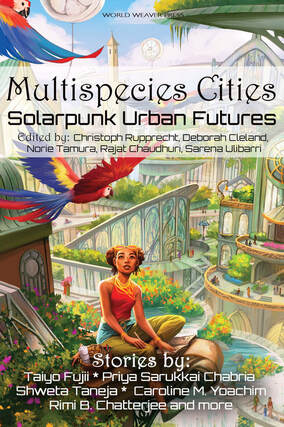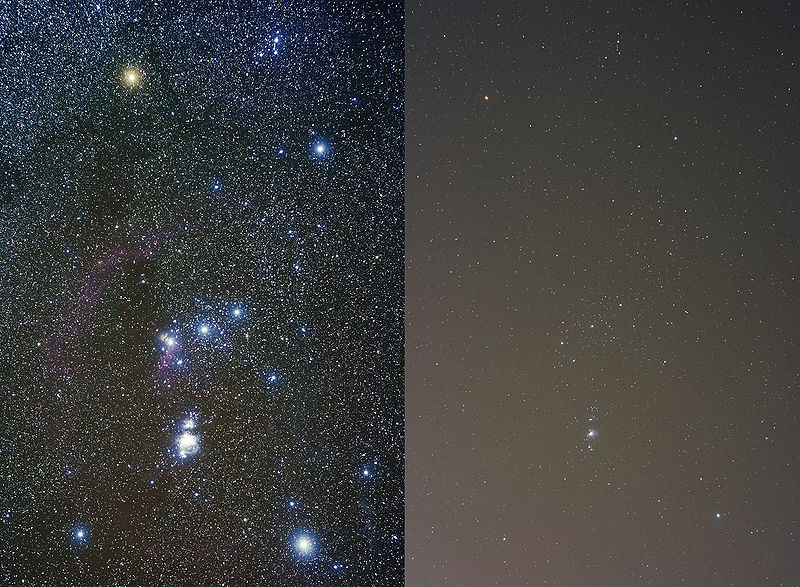 Guest Blog by N. R. M. Roshak In January 1994, a 6.7-magnitude earthquake shook Los Angeles. The Northridge earthquake rumbled through at 4:30 AM, waking residents and taking out the power grid. People poured out of their homes and into the darkened streets. And some of them dialed 911, not about the earthquake, but about what they saw in the dark sky: a strange “giant, silvery cloud” arching over the stricken city. That mysterious cloud? It was the Milky Way. The LA residents who called 911 on the Milky Way had likely never seen it before. LA's light pollution is notorious. Light spilling into the sky from streelights, buildings, signs, and searchlights is refracted by the coastal haze, creating an intense skyglow. LA's skyglow is particularly intense--pilots say they can see it from 200 miles away. The sky's brightest stars are barely visible, let alone the Milky Way. And LA isn't the only city affected. Most urban residents have trouble seeing the stars. This picture shows the constellation Orion, seen from the countryside and seen from the city. Unfortunately, the glow of light pollution has worse consequences than shutting humans off from the stars. Many animals' biology and lives are thrown off by nighttime lighting. And it doesn't take a city as bright as LA to affect them. Brightly-lit towers and tall buildings can confuse migratory birds so badly that they circle the towers until they collapse from exhaustion. Lights disrupt frogs' nighttime croaking. Baby sea turtles, who hatch on beaches, instinctively turn toward light to find the ocean--a strategy that worked for millions of years, when the sky over the open ocean was brighter than the land's shadow, but that fails when the land is topped with a city's glow. And this is only the tip of the iceberg. Dozens of species of mammals , reptiles , amphibians, insects, and even aquatic species like coral are affected by our cities' light pollution. These two consequences of urban skyglow — humans blinded to the stars, animals led astray — come together in my story for Multispecies Cities, "By The Light of the Stars". It's a gently speculative queer romance about turtle hatchlings who need a little help to find the ocean, and a human who needs a little help to believe in the stars. Writing this story opened my eyes to the effects of light pollution on all of us, human and animal. And it pains me that I can't show my own kid the stars from our urban home. If you have a kid that you'd like to share the stars with, I invite you to check out the free STEAM activities and readings on my blog: http://nrmroshak.com/how-many-stars-do-you-see-at-night/ And, if you're interested in learning more about light pollution, https://www.darksky.org is a good place to start. The characters in my story find a speculative solution to the turtles' problem; we can't do that in real life, but we can advocate for less light pollution and darker skies in our cities, for the sake of our turtles, birds, bats, frogs, corals, etc. and for ourselves. N. R. M. Roshak writes all manner of things, including (but not limited to) short fiction, kidlit, non-fiction and translation. Her short fiction has appeared in Flash Fiction Online, On Spec, Daily Science Fiction, Future Science Fiction Digest, and elsewhere, and was awarded a quarterly Writers of the Future prize. She studied philosophy and mathematics at Harvard; has written code and wrangled databases for dot-coms, Harvard, and a Fortune 500 company; and has blogged for a Fortune 500 company and written over 100 technical articles. She shares her Canadian home with a small family and a revolving menagerie of Things In Jars. You can find more of her work at http://nrmroshak.com, and follow her on Twitter at @nroshak.
0 Comments
Your comment will be posted after it is approved.
Leave a Reply. |
World Weaver PressPublishing fantasy, paranormal, and science fiction. Archives
February 2024
|
- Home
-
Books
-
All Books
>
- Beyond the Glass Slipper
- Bite Somebody
- Bite Somebody Else
- Black Pearl Dreaming
- Cassandra Complex
- Causality Loop
- Clockwork, Curses, and Coal
- Continuum
- Corvidae
- Cursed: Wickedly Fun Stories
- Dream Eater
- Equus
- Fae
- Falling of the Moon
- Far Orbit
- Far Orbit Apogee
- Fractured Days
- Frozen Fairy Tales
- Glass and Gardens: Solarpunk Summers
- Glass and Gardens: Solarpunk Winters
- Grandmother Paradox
- Grimm, Grit, and Gasoline
- Haunted Housewives
- Heir to the Lamp
- He Sees You When He's Creepin': Tales of Krampus
- Into the Moonless Night
- Jack Jetstark's Intergalactic Freakshow
- King of Ash and Bones (ebook)
- Krampusnacht
- Last Dream of Her Mortal Soul
- Meddlers of Moonshine
- Mothers of Enchantment
- Mrs Claus
- Multispecies Cities
- Murder in the Generative Kitchen
- Recognize Fascism
- Scarecrow
- Sirens
- Shards of History
- Shattered Fates
- Skull and Pestle
- Solarpunk (Translation)
- Solarpunk Creatures
- Solomon's Bell
- SonofaWitch!
- Speculative Story Bites
- Trenchcoats, Towers, and Trolls
- Weredog Whisperer
- Wolves and Witches
- Anthologies and Collections
- Novels
- Novellas
- Fairy Tale
- Fantasy
- Romance
- Science Fiction
- Urban/Contemporary Fantasy
- Young Adult SFF
-
All Books
>
- Blog
- About
- Contact
- Press / Publicity
- Newsletter Signup
- Privacy Policy
- Store


 RSS Feed
RSS Feed